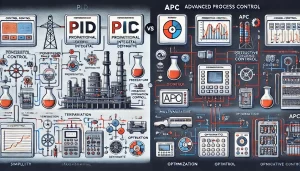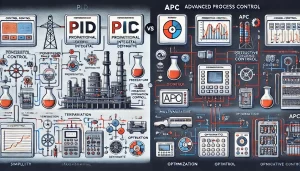In the world of industrial automation and process control, PID (Proportional-Integral-Derivative) control and APC (Advanced Process Control) are two fundamental strategies used to regulate systems and maintain desired outputs. While both serve the purpose of controlling industrial processes, they are fundamentally different in terms of complexity, application, and performance. This article explores the details of each control method and highlights the differences between them.
PID Control: The Classic Approach
PID control is one of the most widely used control algorithms in industrial processes due to its simplicity and effectiveness in various applications. It is a feedback-based control system that continuously adjusts the control output based on the difference (error) between the desired setpoint and the actual output of the system.
Components of PID Control
- Proportional (P):
The proportional term reacts to the current error between the setpoint and the measured output. The larger the error, the stronger the control response. Proportional control is aimed at reducing the error quickly, but if used alone, it can result in steady-state errors and overshoot.Formula:P=Kp⋅e(t)P = K_p \cdot e(t)Where KpK_p is the proportional gain and e(t)e(t) is the current error. - Integral (I):
The integral term accumulates past errors over time and adjusts the control action accordingly. This helps in eliminating steady-state error by ensuring that even small errors are addressed over time. However, the integral action can introduce lag and lead to instability if not carefully tuned.Formula:I=Ki⋅∫e(t)dtI = K_i \cdot \int e(t) dtWhere KiK_i is the integral gain and e(t)e(t) is the accumulated error. - Derivative (D):
The derivative term predicts the future behavior of the error by considering the rate of change of the error. It provides a damping effect, reducing overshoot and improving system stability by reacting to rapid changes in the error.Formula:D=Kd⋅de(t)dtD = K_d \cdot \frac{de(t)}{dt}Where KdK_d is the derivative gain and de(t)dt\frac{de(t)}{dt} is the rate of change of the error.
Working of PID Control
The PID controller calculates the control signal as a sum of the proportional, integral, and derivative terms:
Control Output=P+I+D\text{Control Output} = P + I + D
This simple control algorithm continuously adjusts the system’s input to minimize the error over time. PID controllers are particularly effective in systems where the process is linear and time-invariant, such as temperature regulation, pressure control, or liquid level management.
APC (Advanced Process Control): A Modern and Sophisticated Method
Advanced Process Control (APC) is a more sophisticated form of process control that goes beyond the limitations of basic PID control. APC typically involves a combination of multiple techniques, including Model Predictive Control (MPC), nonlinear control, and real-time optimization, to control complex and multi-variable processes in real-time.
Key Features of APC
- Model Predictive Control (MPC):
One of the most common approaches within APC is MPC, which uses a mathematical model of the process to predict future system behavior. Based on this prediction, the controller calculates optimal control actions to minimize future errors and optimize performance. - Multivariable Control:
Unlike PID, which typically handles single-input and single-output (SISO) systems, APC can manage multivariable systems (MIMO), where multiple inputs and outputs interact with each other. This is critical in complex industrial processes like chemical reactions, where changes in one parameter affect others. - Optimization and Constraints Handling:
APC not only controls the process but also optimizes it in real-time by handling constraints (such as safety limits, operational limits, etc.) and adjusting parameters to achieve the most efficient operation. - Adaptive Control:
Many APC systems are designed to be adaptive, meaning they can adjust their control parameters automatically as the system dynamics change over time. This is particularly useful for processes that are non-linear or have varying operational conditions.

Applications of APC
APC is typically used in complex industrial sectors such as:
- Petrochemical industries
- Refineries
- Pharmaceutical manufacturing
- Pulp and paper processing
- Metallurgical processes
These processes often involve multiple variables that need to be controlled simultaneously, and APC’s ability to predict, optimize, and handle constraints makes it a more effective choice than traditional PID control.
Differences Between PID and APC
| Feature | PID Control | APC (Advanced Process Control) |
|---|---|---|
| Control Strategy | Feedback control based on error (setpoint vs actual value) | Model-based predictive control with optimization capabilities |
| Complexity | Simple, easy to implement | More complex, requires mathematical modeling and optimization |
| Number of Variables | Primarily used for single-input, single-output (SISO) | Can handle multiple-input, multiple-output (MIMO) systems |
| Prediction Capability | No prediction of future system behavior | Predicts future behavior using a model |
| Adaptation | Parameters are fixed and need manual tuning | Self-adaptive, adjusts automatically to changing conditions |
| Optimization | No real-time optimization | Optimizes performance and handles process constraints |
| Use Case | Simple systems (temperature, pressure, etc.) | Complex industrial processes (chemical plants, refineries) |
| Implementation | Easy to set up and tune for linear systems | Requires model development and advanced software |
Conclusion
PID and APC are two different approaches to industrial process control, each with its strengths and limitations. PID control is effective, simple, and widely used for single-variable systems where the process is linear and time-invariant. It offers a balance between simplicity and performance, making it ideal for straightforward control applications.
On the other hand, APC is designed for more complex, multi-variable systems and offers advanced features like predictive control, real-time optimization, and adaptive capabilities. While it is more complicated to implement, it provides significant benefits in controlling dynamic, nonlinear, and constrained industrial processes.
Ultimately, the choice between PID and APC depends on the complexity of the process being controlled, the need for optimization, and the required precision. For simple systems, PID may suffice, but for modern industrial applications that demand high levels of efficiency and performance, APC offers a more powerful solution.

